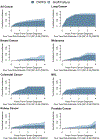Changes in cancer incidence and outcomes among kidney transplant recipients in the United States over a thirty-year period
- PMID: 33159960
- PMCID: PMC8096865
- DOI: 10.1016/j.kint.2020.10.018
Changes in cancer incidence and outcomes among kidney transplant recipients in the United States over a thirty-year period
Abstract
Recipients of kidney transplants have elevated cancer risk compared with the general population. Improvements over time in transplant care and cancer treatment may have affected incidence and outcomes of cancer among recipients of kidney transplant. To evaluate this, we used linked United States transplant and cancer registry data to study 101,014 adult recipients of kidney transplants over three decades (1987-1996, 1997-2006, 2007-2016). Poisson regression was used to assess trends in incidence for cancer overall and seven common cancers. Associations of cancer with risk of death-censored graft failure (DCGF) and death with functioning graft (DWFG) were evaluated with Cox regression. We also estimated absolute risks of DCGF and graft failure following cancer for recipients transplanted in 2007-2016. There was no significant change in the incidence of cancer overall or for six common cancers in recipients across the 1987-2016 period. Only the incidence of prostate cancer significantly decreased across this period after multivariate adjustment. Among recipients of kidney transplants with non-Hodgkin lymphoma, there were significant declines over time in elevated risks for DCGF and DWFG but no significant changes for other combined cancers. For recipients transplanted in the most recent period (2007-2016), risks following cancer diagnosis remained high, with 38% experiencing DWFG and 14% graft failure within four years of diagnosis. Absolute risk of DWFG was especially high following lung cancer (78%), non-Hodgkin lymphoma (38%), melanoma (35%), and colorectal cancer (49%). Thus, across a 30-year period in the United States, there was no overall change in cancer incidence among recipients of kidney transplants. Despite improvements for non-Hodgkin lymphoma, cancer remains a major cause of morbidity and mortality.
Keywords: cancer; graft failure; incidence; kidney transplant; mortality.
Published by Elsevier Inc.
Figures

References
-
- Hart A, Smith JM, Skeans MA, et al. OPTN/SRTR 2017 Annual Data Report: Kidney. Am J Transplant 2019;19 Suppl 2:19–123. - PubMed
-
- Grulich AE, van Leeuwen MT, Falster MO, Vajdic CM. Incidence of cancers in people with HIV/AIDS compared with immunosuppressed transplant recipients: a meta-analysis. Lancet 2007;370:59–67. - PubMed
-
- Guba M, Graeb C, Jauch KW, Geissler EK. Pro- and anti-cancer effects of immunosuppressive agents used in organ transplantation. Transplantation 2004;77:1777–82. - PubMed
Publication types
MeSH terms
Grants and funding
- U58 DP003931/DP/NCCDPHP CDC HHS/United States
- HHSN261201000037C/CA/NCI NIH HHS/United States
- U58 DP003875/DP/NCCDPHP CDC HHS/United States
- HHSN261201000036C/CA/NCI NIH HHS/United States
- N01 PC035139/CA/NCI NIH HHS/United States
- N01 PC035137/CA/NCI NIH HHS/United States
- HHSN261201300071C/CA/NCI NIH HHS/United States
- U58 DP003920/DP/NCCDPHP CDC HHS/United States
- N01 PC035142/CA/NCI NIH HHS/United States
- U58 DP003933/DP/NCCDPHP CDC HHS/United States
- HHSN261201800002C/CA/NCI NIH HHS/United States
- U58 DP000824/DP/NCCDPHP CDC HHS/United States
- HHSN261201800002B/CA/NCI NIH HHS/United States
- U58 DP003883/DP/NCCDPHP CDC HHS/United States
- N01 PC035143/CA/NCI NIH HHS/United States
- HHSN261201000035C/CA/NCI NIH HHS/United States
- HHSN261201300011C/RC/CCR NIH HHS/United States
- U58 DP000807/DP/NCCDPHP CDC HHS/United States
- HHSN261201300021C/CA/NCI NIH HHS/United States
- HHSN261201000035I/CA/NCI NIH HHS/United States
- U58 DP000848/DP/NCCDPHP CDC HHS/United States
- Z01 CP010150/ImNIH/Intramural NIH HHS/United States
- HHSN261201000034C/CA/NCI NIH HHS/United States
- U58 DP003921/DP/NCCDPHP CDC HHS/United States
LinkOut - more resources
Full Text Sources
Other Literature Sources
Medical

